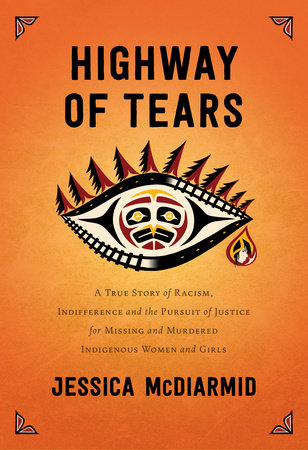You may have guessed from the title that this is not going to be a feel good book. And you will be correct. I first heard about the Highway of Tears when it came up in a wonderful, spooky, very Canadian book I read called "A Man Came Out of a Door in the Mountain" . I blogged about it briefly here (that is one of my favorite posts I have ever done, as an aside).
Here is our brief overview to get us started. The Highway of Tears is Hwy 16 that runs through southern British Columbia. It is a desolate stretch of highway that connects teeny, tiny, mostly indigenous towns, some incredibly far apart, over it's 700-some off kilometer span. This book is about the staggering amount of girls and women who have disappeared along this stretch of highway - who they were, what may have happened to them, how the police and government failed them and their families aaaaaaand racism at all levels.
Let's start with the state of the indigenous people of Canada, and sometimes specifically the province of British Columbia, just for more perspective:
- Indigenous women are 6 times more likely to be murdered than a white woman
In B.C. , 1 in 5 indigenous children has encountered the child welfare system. Other places in Canada it's 1 in 30 for non-indigenous kids
-The indigenous children who are in the child welfare system are at an alarmingly higher risk for sexual assaults, suicide, drug problems, HIV and other serious risks
The long and short of this terrible paragraph is that it is really tough to be poor and indigenous in this part of Canada. The odds are stacked against you, literally from birth.
So, there's the area that the H.O.T. runs through. An overwhelming majority of the victims are indigenous. You would think that the fact that an insane amount of people have disappeared, most of them without a literal trace, and that there might be a serial killer on the loose would be the main problem. I mean, it is, but there are so many other problems.
The very first problem is that no one knows how many women have actually disappeared along this highway. Numbers range from the 40s into the 100s. I can't believe that it's less than 100. The women that we know of age in range from their early teens to their late 40s. Some of them were hitchhiking (a very common practice for this area and these communities), some of them literally just walked out of their houses, away from friends, away from a party and were never seen again. Why are they hitching? Cars in this area can be a luxury item, and there is not a bus that runs this route with any type of consistency,.
Part of the reason that we don't have an accurate number of disappearances is the police. A lot of the victims went through the above mentioned child welfare system in Canada - so many of them had had run ins with the law, maybe a drug problem, almost all of them were born into the kind of poverty that I can't imagine. Some of the police (usually the mounties) were very quick to dismiss a lot of these victims as (in least offensive scenarios) people who left for seasonal work, or just ran off to Vancouver or (in more offensive scenarios) people who fled the police because they had warrants out, had a drug problem, or had, you know, otherwise got what was coming to them because they had a risky lifestyle. As you can imagine, this does not make for a great relationship between the victims families and the police. The amount of mistrust is palpable. Some of the police never wrote a report, never helped mount search efforts. These are people who feel that they are "over-policed and under-protected", which is an incredibly succinct phrase if I've ever heard one.
There have been so many symposiums and talks about what can be done to make the highway safer. Almost none of them have been implemented. Which probably wouldn't have helped because it doesn't get to the root of any of these larger problems.
Here are the two things that I can't stop thinking about with this book.
1. This book didn't talk about any close calls. Like, maybe a girl got in a truck and a man pulled a knife and she got away and could give the police a description. When these girls get taken they are just gone. And so few of the bodies are found because the area is so remote and animals and a lot of time these families are out here looking by themselves.
2. A goddamn Greyhound bus would have saved a lot of these girls. Not all of them. But some. Some sort of consistent public transportation that would provide a safer option for these people would move mountains in so many ways in these under served communities. Just a goddamn bus.
Women are still disappearing off of this highway.
If you are looking for more information on this terrible situation there are a few places I will point you to: the Carrier Sekani Family Services website , this quick video produced by Vice, and of course there is always Wikipedia.

Thanks for the overview. I think I will add this to my Goodreads list of books to read
ReplyDelete